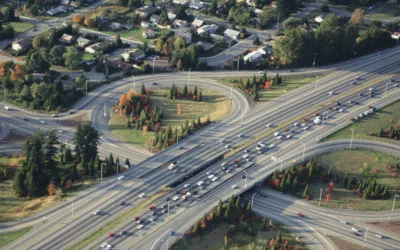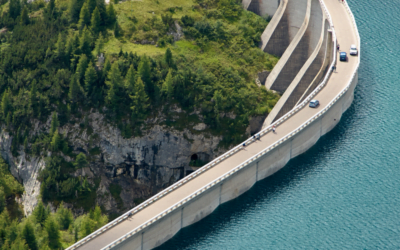As early as 1828, Thomas Tredgold defined the field of civil engineering in terms that still resonate today.
“Civil engineering is the art of directing the great sources of power in nature for the use of convenience of man.”
This can only be done with a solid foundation of data designed to help you understand those forces and their use. This is why civil engineering data capture is so important – and why the evolving technologies in this space are so exciting.
Newtecnic Founder Andrew Watts explains why data is key in civil engineering. He says,
“Turning data into accessible knowledge delivers better operational efficiency and financial returns for civil engineering.”
Since accurate data plays such an integral role in effective civil engineering, how that data is collected makes all the difference. Recent developments have made this process faster – and more accurate – than ever before.
Two civil engineering data capture techniques that will revolutionise the way we work are thermal imaging, and drones. This week, we’re looking at how thermal imaging can improve the way civil engineers capture data, and the quality of the data they capture.
Infrared Scanning & Thermal Imaging
Thermal imaging is not all that new. In fact, the BBC reports that “the first documented civilian life saved with thermal imaging technology was following the 1985 Putney gas explosion in London.”
The technology has come a long way since then.
Thermal imaging cameras measure the infrared radiation emitted by objects. This means that any object with a temperature above absolute zero can be seen using thermal imaging technology. This technology also overcomes the kinds of challenges that would usually make it difficult, or even impossible, to view and assess a structure, such as smoke, foliage, or even other structures.
Types of thermal imaging
There are two primary types of thermography. Pulse thermography (PT) is a non-destructive testing method used to identify defects. The item being measured is stimulated with short pulses of video, flash, or transient thermography. Lock-in thermography (LT), in which an energy waved is applied to the outside of an object and the resulting readings are recorded.
Both PT and LT are passive infrared thermography techniques. These are used for detecting defects in reinforced concrete structures.
Vibrothermography is an active thermography technique, with post processing techniques. It uses ultrasonic waves (amplitude modulated or pulses) to excite internal features.
Why use thermal imaging?
Thermal imaging is both non-destructive and non-contact. This means it gives us the ability to see inside structures without taking them apart or even being very close to them. Thermal imaging is particularly useful for getting data from structures that are exceptionally warm, such as smoke stacks, or very high and hard to reach safely
How does thermal imaging work?
Objects or structures are stimulated. For external observation purposes, this is done with either photographic flashes or halogen lamps. Using these tools, a heat pulse is applied to the surface of the object or structure.
For internal examinations, stimulation is done using either a sonic or ultrasonic transducer.
In each case, the surface temperature of the object will change during the heating and cooling phases. This change is monitored and recorded.
Once enough variation has been recorded, the recording device can generate an image of the object that is being examined, showing its flaws and defects. This can be used to understand problems with the building envelope, as well as deeper internal structural issues.
What can you do with thermal imaging?
Thermal imaging can detect a wide range of construction issues that may be invisible to the naked eye. Even though these problems can’t easily be spotted, they can be dangerous for anyone using the structure. These defects could include voids in concrete or masonry, delaminations at where materials of different density have been composited together, and heat capacity or conductivity problems.
The beauty of thermal imaging is that it is completely non-destructive, and will not damage whatever is being tested. This makes it a powerful tool for non-destructive evaluation (NDE) of materials and structures. It is a non-contact technique, which simplifies the measurement process and also makes it perfect for fast 2D mapping of surfaces.
For thermal imaging to work effectively, it’s important to have:
- Enough temperature contrast between the thing being analysed and all the things around it to provide a clear picture of what is being viewed;
- Effective, appropriate equipment in good working order; and
- An experienced thermographer to interpret and explain the results.
What are the limitations of thermal imaging?
No technology is without its drawbacks. Thermal imaging is an extremely effective way to understand a structure without taking it apart, or even touching it. However, this technique relies heavily on the weather. It works best on clear, bright days. Wind, cloud cover, and rain can all make it impossible to use thermal imaging for certain projects.
Delamination defects in composite concrete structures are sometimes missed. The technology is always improving, though. As it gets better, fewer of these issues will slip through the cracks.
The exciting news is that these advances in thermal imaging technology are making it easier than ever to identify tiny imperfections that could never have been spotted before.
Bojan Milovanović is a professor of civil engineering at the University of Zagreb. He outlines the potential of thermal imaging in civil engineering in a fascinating 8-page paper, which can be downloaded.
Do you use thermal imaging in your work? We’d love to hear your thoughts on the technology, and find out more about your experiences. Drop us a line and let us know what you think about using thermal imaging in civil engineering.




0 Comments